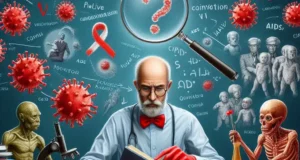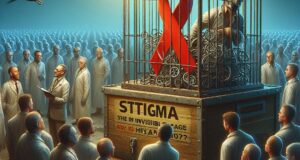Imagine a fire starting in a distant part of a city. Instead of ringing the alarm and rushing to extinguish it, some people close their doors, convinced the fire only burns certain homes. This fire is HIV/AIDS. And the closed doors? They’re built by homophobia — a prejudice that delayed the world’s response to the epidemic and allowed it to spread unchecked.

In the early 1980s, when whispers of a new, deadly illness began to emerge, the first known patients in the U.S. were mostly gay men. Instead of empathy, society responded with blame. When people asked “AIDS where did it come from?”, the answer was often coated in judgment, not science. The virus was quickly labeled “the gay disease,” and homophobia became the lens through which the world saw the epidemic.
Homophobia didn’t just live in casual comments or hateful slurs — it was systemic. It existed in hospitals that refused treatment, in media that avoided coverage, and in governments that stayed silent. Picture HIV as a storm approaching — and homophobia as the wall that blocked both the warning sirens and the shelters. The result? Countless lives lost that could have been saved.
The stigma was so thick that even the word “AIDS” carried a whisper of moral accusation. People believed the disease was a punishment, not a public health crisis. Leaders avoided the topic entirely. Major news outlets took years to cover it seriously. And those who were suffering? They were left to fight alone — their pain hidden behind a curtain of shame.
When we trace the question “AIDS where did it come from?”, the true answer is rooted in science. HIV likely crossed from chimpanzees to humans in Central Africa, through the hunting and butchering of animals. But in the West, especially in the U.S., homophobia twisted this question into a weapon. It was no longer about virology — it became a justification for discrimination.
Imagine a battlefield where one side is fighting a real, biological virus, and the other side is swinging at people, not pathogens. That’s what homophobia did. It turned the fight against AIDS into a moral war, not a medical one. While activists begged for funding and awareness, doors remained closed. People with HIV weren’t seen as patients; they were painted as criminals in the court of public opinion.
This attitude didn’t just hurt gay men — it hurt everyone. As the virus spread beyond the LGBTQ+ community to heterosexual individuals, hemophiliacs, women, and children, the lack of early action made the epidemic worse. Homophobia didn’t protect anyone — it endangered everyone.

Even within families, fear fueled by prejudice led to isolation. Some were kicked out of their homes. Others died without ever being touched or spoken to again by loved ones. The question “AIDS where did it come from?” was rarely asked with compassion — more often it was an accusation.
But brave voices rose. Activists, many from the gay community, fought to change the narrative. They turned their grief into action — marching, educating, demanding visibility. They carried not just signs, but the weight of millions who were ignored. Slowly, the world began to listen.
Today, HIV is a treatable condition. With proper medication, people can live full, healthy lives. But the emotional scars left by homophobia remain. And in some places, the discrimination still exists — just more quietly. That’s why it’s important to remember the damage it caused.
So when we hear someone ask, “AIDS where did it come from?”, let’s give them the full truth. Yes, explain the science. But also tell them about the silence, the stigma, and the hate that allowed the virus to grow while the world looked away.
Because homophobia wasn’t just a social problem — it was a public health failure.




